|
Arrangements & Transcriptions of Bach's Works
Works using the Name Bach (The BACH Motif)
Part 4: N-Z |
|
< Continue from Part 3 |
|
|
N Bach | A | B | C | D | E | F | G | H | I | J | K | L | M | N | O | P | Q | R | S | T | U | V | W | X | Y | Z |
|
Composer |
Work |
Year |
Works
Recordings |
|
Gerhard Naprstek |
Fantasie und Fuge über b-a-c-h, for organ |
1965 |
|
|
Dieter Nathow |
Variations on B-A-C-H, in Divertimento über B-A-C-H [collaborative composition], for orchestra |
1984 |
|
|
Vaclav Nelhybel |
Concerto spirituoso No. 4, for solo voice, solo string quartet (taped and live) & orchestra: Variants on B-A-C-H and Hans Leo Hassler's O sacred head, now wounded
[Clifton, N.J. : European American Music Corp., 1977] |
1977 |
|
|
Ron Nelson (b 1929) |
Passacaglia (Homage on B-A-C-H), for concert band |
1993 |
|
|
Stefan Németh-Šamorínsky (1896-1975) |
Accommodatio ad nomen B-A-C-H, for organ |
1972 |
|
|
Anthony Newman (b 1941) |
Bhajeb. Bhajebochstiannanas. <An anagram on the name Johann Sebastian Bach.>, for organ
[New York, London : G. Schirmer, 1974] |
1974 |
|
|
Şerban Nichifor (b 1954) |
Choralis anamorphoticus in honorem J. S. Bach , for organ
[Bucureşti: Ed. Muzicalã, 1988] |
1988 |
|
|
Jan Nieland (1903-1963) |
Fantasie et Fuga sopra B-A-C-H, for organ
[Amsterdam: Edition Heuwekemeijer, c1943]
[Philadelphia: Elkan-Vogel Co. Inc.] |
c1943 |
|
|
Carl Nielsen (1865-1931) |
Concerto for Violin and Orchestra, Op. 33, FS 61
[Frankfurt: Wilhelmiana Musikverl. København : Hansen, London: Chester. Oslo: Norsk Musikforl. Stockholm: AB Nordiska Musikförl., c1980]
Source: Talk Bach motif (Wikipedia) |
1911 |
|
|
Riccardo Nielsen |
Ricercar, Choral und Toccata, for piano |
|
|
|
Hans Peter Nowak |
BACH (Johannes R. Becher, “Die Klänge zögern noch"), for voice & piano |
1978 |
|
|
Dieter Nowka |
Passacaglia and Fugue, in Hommages, for piano |
|
|
|
O Bach | A | B | C | D | E | F | G | H | I | J | K | L | M | N | O | P | Q | R | S | T | U | V | W | X | Y | Z |
|
Composer |
Work |
Year |
Works
Recordings |
|
Reinhard Ohse |
Konzert in drei Sätzen, for organ, strings & chorus |
1975 |
|
|
Heinz Bernhard Orlinski (b 1928) |
Fantasia meditativa super B-A-C-H, for organ
[Düsseldorf: Ed. Schwann 2363, 1972] |
1972 |
|
|
P Bach | A | B | C | D | E | F | G | H | I | J | K | L | M | N | O | P | Q | R | S | T | U | V | W | X | Y | Z |
|
Composer |
Work |
Year |
Works
Recordings |
|
Traugott Immanuel Pachaly |
Fuga über den Namen Bach, for organ
[Erfurt: Körner, c1848] |
c1848 |
|
|
Mario Pagotto |
Capriccio on B.A.C.H., for flute, 2 violins, viola, violoncello & piano
[Roma: Rai Trade, 2009] |
2005 |
|
|
Oscar von Pander |
b-a-c-h - Suite for piano 4 hands |
|
|
|
Desiree Pâique |
Fuguette sur le nom de “Bach", No. 2 from (10) Compositions for organ
[Berlin: Simrock 1913] |
1913 |
|
|
Arvo Pärt |
Collage sur B-A-C-H, for oboe and strings |
1964 |
Recordings |
|
Arvo Pärt |
Collage sur B-A-C-H, for oboe, string orchestra, harpsichord and piano
[Leningrad: Musyke. Hamburg: Sikorski] |
1969 |
Recordings |
|
Arvo Pärt |
Wenn Bach Bienen gezüchtet hätte:
Fassung A: for harpsichord, electric guitar, prepared tape & instrumental ensemble
Fassung B: for harpsichord, 8 violins, 4 violas, 4 violoncelli & 2 double bass
Fassung Witten 1984: for string quartet, wind quintet, piano & double bass
[Vienna: Universal Edition] |
1984 |
|
|
Arvo Pärt |
Concerto piccolo über b-a-c-h = Concerto piccolo on b-a-c-h, for trumpet, strings, harpsichord and piano (arrangement of Collage sur B-A-C-H)
[Hamburg: Sikorski, c1996] |
1996 |
|
|
Zane Pautz |
On the name B-A-C-H, for unaccompanied women's voices in four parts |
1983 |
|
|
Krzysztof Penderecki (b 1933) |
Passio et mors Domini nostri Jesu Christi secundum Lucam (Lukas Passion), for narrator, solo voices, boys' choir, mixed choir, orchestra & organ
[Krakow: Polskie wydawnictwo muzyczne, 1967]
[Celle: Moeck Nr. 5028, 1967] |
1963-1965 |
|
|
Craig Penfield |
Fantasy on B-A-C-H, for organ
Source: Laurel Heights United Methodist Church [PDF] |
2011 |
|
|
Ernst Pepping |
Drei Fugen über BACH: C-dur; F-dur; a-moll, for piano
[London: Schott ED 3959 (Klavierfassung), 1944; ED 3818 (Orgelfassung)] |
1943 |
|
|
Ernst Pepping |
Drei Fugen über BACH, for piano 4 hands
[Mainz: B. Schott's Söhne, 1944] |
1944 |
|
|
Ernst Pepping |
Drei Fugen über BACH, for organ
[Mainz: B. Schott's Söhne, 1949] |
1949 |
|
|
Coleridge-Taylor Perkinson (b 1932) |
Sinfonietta No. 2: Generations, for string orchestra
[Saint Louis, MO : MMB Music, 1996] |
1996 |
|
|
His four-movement Sinfonietta No. 2 for Strings is named Generations because each of its movements is dedicated to family members. According to the composer's notes, the first, combining the perennially popular BACH motif (Bb-A-C-B in German notation) with the folk tune "Mockingbird," is for his daughter. The second, a sarabande, is dedicated to "the matriarchs" of his family; the third, a scherzo entirely pizzicato, is for his grandson, and the fughetto finale, which uses the themes from the first movement and a new one that is African in origin, is for "the patriarchs." Each movement is striking in itself, but for this listener, each is also too long for the musical material or development it contains - with the exception of the very brief scherzo/burletta.
Source: Enjoy the Music: African Heritage Symphonic Series |
|
|
|
Oscar Peterson (1925-2007) |
The Bach Suite: Allegro, Andante, Bach's Blues
In: Oscar Peterson Live! (Oscar Peterson - piano; Joe Pass - guitar; David Young - double bass; Martin Drew - drums) (Pablo) |
1986 |
|
|
Frank Petzold |
BACH-Metamorphosen and Toccata, in Divertimento über B-A-C-H [collaborative composition], for orchestra |
1984 |
|
|
Christian Pezold |
Fuga sub Diatessaron La Guide à pra soil Nome del celebre Signor Bach. F-Dur, for organ
[Dresden: SLB Mus. ms. 2354, U/l]
(In: Christian Pezold, Fugue per L'Organo ô Clavicembalo) |
|
|
|
Franz Pfister |
B.A.C.H. für Andreas, for piano
[Sursee : [F. Pfister], 2000] |
2000 |
|
|
Reinhard Pfundt |
lnventiones über B-A-C-H, for string quartet |
1985 |
|
|
Roberto Piana (b 1971):
Tre movimenti sul nome BACH, for flute solo |
|
Tibor von Pikethy |
Fantasia sur la thème BACH, Op. 28, for organ
[Brussels: Schott SF 8825, 1949] |
1949 |
|
|
Walter Piston (1894-1976) |
Chromatic Study on the name of Bach, for organ
[London: Novello and Co., Ltd., 1941]
[New York: H.W. Gray, 1941] (No. 3 of “Contemporary Organ Series") |
1940 |
|
|
Carl Piutti |
Fest-Hymnus, Op. 20, for organ (premiered 1890)
[Leipzig: Rieter-Biedermann]
[Leipzig: Edition Peters 4359]
[New York: C.F. Peters] |
1890 |
|
|
Carl Piutti |
28. Juli 1750, Op. 32 No. 8, for organ (uses the Bach motif) |
|
|
|
Hans Wilhelm Plate |
Fuß-Noten zu B-A-C-H, Kanonische Episoden, for 3 flutes, string trio & harpsichord |
1977 |
|
|
Andreas Pflüger |
B-A-C-H, for wind quintet (flute, oboe, clarinet, bassoon & horn)
[Lugano: Ed. Plural, 2001] |
2001 |
|
|
Wladimir Pogojeff |
Fuge über b-a-c-h, in: Quattre Fugues Op. 2. No. 2, for piano |
1902 |
|
|
Giovanni Battista Polleri (1855-1923) |
Preludio e fuga sul tema "Fede a Bach": dato da Arrigo Boito, for organ
[Bergamo: Edizioni Carrara, 2004?] |
1888 ? |
|
|
Andreas Porfetye (b 1927) |
Fantasia super B-A-C-H et Lamentatio Jeremiae Prophetae, for organ
[Wiesbaden: Breitkopf & Härtel, Ed. Breitkopf Nr. 6617, 1971] |
1968 |
|
|
Francis Poulenc |
Valse-improvisation sur le nom de BACH, for piano, FP 62 (No. 3 from Hommage à J.S. Bach)
[Paris: La Revue Musicale XIII, Supplément musical III, Dec 1932]
[Ronart Lerolle und Cie, 1939] |
1932 |
Recordings |
|
Bud Powell (1924-1966) |
Bud On Bach, for Jazz trio of piano, double bass & drums
In: But Powell: “The Amazing Bud Powell, Vol. 3 - Bud!” (Blue Note)
Played by Bud Powell (p) Paul Chambers (b); Art Taylor (d) |
1957 |
Uses BACH motif? |
|
José Antônio Rezende de Almeida Prado (1943-2010) |
Concerto Fribourgeois , for piano & strings: Toccata
Source: Talk Bach motif (Wikipedia) |
1985 |
Works |
|
Procol Harum (Rock band) |
''A Whiter Shade of Pale''
In: Procol Harum: “Procol Harum” (Regal Zonophone Records UK; Deram Records USA] |
1967 |
Uses BACH motif? |
|
1967 Procol Harum's ''A Whiter Shade of Pale'' - based on a Bach motif - hits the top 10.
Source: Entertainment Weekly |
|
|
|
Frank Proto (b 1941) |
Five Divertimenti, for Solo Violin |
|
|
|
Proto's strength is the clarity with which he manipulates his ideas on paper. The last movement of the divertimento No. 1 is a devilishly clever realization of how different strands of material can be contained at the same time, and the Divertimento No. 4 slyly builds the B-A-C-H motif into a vast network of underpinning structural impulses and scurrying embellishment.
Source: Liner notes to the CD “Frank Proto: Five Divertimenti for Solo Violin” played by Eric Bates, violin (Red Mark Records CD-9221) |
|
|
|
Q Bach | A | B | C | D | E | F | G | H | I | J | K | L | M | N | O | P | Q | R | S | T | U | V | W | X | Y | Z |
|
Composer |
Work |
Year |
Works
Recordings |
|
R Bach | A | B | C | D | E | F | G | H | I | J | K | L | M | N | O | P | Q | R | S | T | U | V | W | X | Y | Z |
|
Composer |
Work |
Year |
Works
Recordings |
|
Irmfried Radauer (1928-1999) |
Perspektivem auf B-A-C-H, for 19 instruments (1.1.1.1.-1.1.1.1., piano, strings (4.2.3.1.0.))
[Munich: Edition Modern] |
1958 |
|
|
Radiohead (alternative rock band) |
Bass line of the songs "Optimistic"
In: Radiohead: “Kid A” (Parlophone)
Source: Wikipedia |
2000 |
|
|
Radiohead (alternative rock band) |
Bass line of the song "Go to Sleep"
In: Radiohead: “Hail to the Thief” (Capitol Records)
Source: Wikipedia |
2003 |
|
|
Thom Yorke (soloist of Radiohead) |
Bass line of the song "Black Swan"
In: Thom Yorke: “The Eraser” (Thom Yorke - vocals, instrumentation; Nigel Godrich - arrangement, production, mixing, instrumentation; Jonny Greenwood - piano) (XL Recordings)
Source: Wikipedia |
2006 |
|
|
Peutti Raito |
Due figure, for orchestra |
1985 |
|
|
Primoz Ramovs |
Utrinki ob Bachovem imenu, for piano |
1965 |
|
|
Alan Rawsthorne (1905-1971) |
Studies on a Theme by Bach , for string trio
[MS in the Rawsthorne Archive] |
1936 |
|
|
The work builds up slowly from the BACH motif. The contrapuntal textures gradually fragment leading to a prestissimo section. There is a middle section in 2/4 that then returns to a recapitulation of the prestissimo. The piece ends with an andante that balances the slow introduction.
Source: PDCA6 |
|
|
|
Siegfried Reda |
Laudamus te, for organ
[Kassel: Bärenreiter BA 4454, 1965] |
1962 |
|
|
Wolfram Rehfeldt |
Fantasie über B-A-C-H, for organ
In: Drei Orgelstücke
[Munich: Strube, c2005] |
2005 |
|
|
Max Reger |
Fantasie und Fuge über den Namen BACH, Op. 46, for organ
[Vienna: Universal Edition, 1900, 1926]
[Munich/Leipzig: Jos. Aibl 1900]
Arrangement for pian (August Stradal)
[Vienna: Universal Edition 1910]
Arrangement for orchestra (Karl Gerigk)
[Vienna: Universal Edition 1933] |
1900 |
Recordings |
|
Johannes Reiche |
Sonata per due, for bass clarinet & percussion |
1985 |
|
|
Karel Reiner |
Dialogy pro dve flétny, for 2 flutes
[Prague: Panton Edition Nr. P 2149, 1982] |
1978 |
|
|
August Reinhard |
Phantasie über den Namen B-A-C-H, Op. 78, for piano 4 hands
[Leipzig: Kahnt Nachf., 1904] |
1904 |
|
|
Willy Renner |
(6) Präludien über den Namen "Bach," Op. 6, for piano
[Leipzig: Steingräber 1914] |
1914 |
|
|
Wilhelm Rettich |
Konzert für Trompete und Orchester über B-A-C-H, Op. 122
[Berlin: Astoria 1971]. |
1970 |
|
|
Josef Rheinberger |
Fuge C-Dur (über BACH), in: 24 Fughetten strengen Styls, Op. 123, Heft I, No. 3, for organ
[Leipzig: C.F. Kahnt 2852, 1884]
[London: Hinrichsen Edition Nr. 47] |
1883 |
|
|
Friedrich Riegel |
6 Fugen über das Thema “Abbach", Op. 24, for organ
[Langensalza: Beyer & Söhne, 1890] |
1890 |
|
|
Helmuth Rilling |
'Aber wenn der Rilling. . .' , F-Dur |
1983 |
|
|
Nikolai Rimsky-Korsakov |
Doppelfuge über B-A-C-H g-Moll (In 3 vierstimmige Fugen), for piano
[Moskau: (N. Rimsky-Korsakow, Polnoye sobraniye sochineniy, Bd. 49a) 1951] |
1875 |
|
|
Nikolai Rimsky-Korsakov |
Fuge über das Thema BACH. 6 Fugen, Op. 17, No. 6 e-Moll, for piano
[St. Petersburg] |
1875 |
|
|
Nikolai Rimsky-Korsakov |
Valse, Intermezzo, Scherzo, Nocturno, PRELUDE ET FUGUE (Six Variations) sur le thème B-A-C-H , Op. 10, Vol. 49a, for piano
[Leipzig: Belaieff; St. Petersburg: Jürgenson Nr. 224]
[Moscow: State Music Publishers, 1959]. |
1878 |
Recordings |
|
Nikolai Rimsky-Korsakov |
Fughetta B-A-C-H, in: Paraphrases / . . . / pour Piano sur le thème favori et obligé, for piano
[Leipzig: Rahter 1880] |
1880 |
|
|
Johann Christian Rinck |
Präludium und Fuge über B-A-C-H (No. 12), for organ, in: Praktische Orgelschule, Op. 55, Teil 6
[Litolff Edition, 1818]
[Bonn & Köln: Simrock 1821]
Neuausgabe: C. H. Rinck, 2 Präludien und Fugen hrsg. v. Hermann J. Busch.
[Hilversum: Harmonia 1975] |
1818 |
|
|
Johann Christian Rinck |
Fantasie, for organ (uses the Bach motif) |
|
|
|
George Rochberg |
Three commentaries: 1. on B-A-C-H; 2. on Pachelbel Canon (and ground bass); 3. on Passacaglia (diatonic and chromatic)
[King of Prussia (Pa.): Theodore Presser, 2007] |
1968-1978 |
|
|
J.S. Bach, edited by Alexander Wilhelm Gottschalg, edited by Andreas Rockstroh |
Präludium und Fuge über B-A-C-H: Orgelbearbeitung nach BWV 898
[Sankt Augustin: Butz, 2003] |
2003 |
|
|
Lionel Rogg |
Méditation sur B.A.C.H., for organ
[Paris: H. Lemoine, 2000] |
2000 |
|
|
Peter Roggenkamp |
B-A-C-H trifft C-A-G-E, from Soundsnew: 19 easy piano pieces
[Vienna [u.a.]: Universal Edition, c2005] |
2005 |
|
|
Claude-Robert Roland
Prélude et fugue sur B-A-C-H (In memoriam II), Op. 20, for organ
[Brussels: CeBeDeM 1984] |
|
Rolf Römer
Opus on B.A.C.H. Eine Komposition unter Verwendung der Initialen und Motive Bachs, for Jazz quartet |
|
Gerhard Rosenfeld |
Concerto, for cello & orchestra |
1967 |
|
|
Franz Georg Rössler |
Invention IV, from “12 Inventionen", for piano
[Wolfenbüttel: Möseler 41.204, 1981] |
1978 |
|
|
Franz Georg Rössler |
Nr. 5 Andante, Hommage à Béla Bartók, from “Eisblumen", for recorder & piano |
1984 |
|
|
Franz Georg Rössler |
Nr. 8 Larghetto, Ritual über zwei Gräben, from “Eisblumen", for recorder & piano |
1984 |
|
|
Nino Rota |
Variazioni e fuga nei 12 toni sul nome di Bach, for piano
[Nuova Carisch]: |
1950 |
Recordings |
|
Nino Rota |
Due Valzer sul nome di Bach, for piano (Circus-Waltz; Valzer-Carillon)
[Revisione di Nicola Scardicchio]: |
1975 |
Recordings |
|
Anny Roth-Dalbert |
B-A-C-H: Fantasie, for organ
[Switzerland: A. Roth, 1986] |
1986 |
|
|
Albert Roussel |
Prélude et Fugue sur le nom Bach (No. 1 from Hommage à J.S. Bach), Op. 40 & 46, for piano
[Paris: La Revue Musical XIII, Supplément musical I, Dec 1932] |
1932-1934 |
Recordings |
|
Léo Roy (b 1887) |
Fugue on BACH, for organ |
|
|
|
Volodymyr P. Runčak (Wladimir Runtschak) |
Bachiana: Meditationen über B-A-C-H (Suiten, Akk Nr. 1, for Bayan accordion
[Kamen: Intermusik Ulrich Schmülling, 1995] |
1995 |
|
|
Anton Ruppert |
Vier Stücke (über B A C H), for trombone & piano
[Munich: Orlando, 1973?] |
1973? |
|
|
S Bach | A | B | C | D | E | F | G | H | I | J | K | L | M | N | O | P | Q | R | S | T | U | V | W | X | Y | Z |
|
Composer |
Work |
Year |
Works
Recordings |
|
Ehsan Saboohi (b 1982) |
Three Psalms on B-A-C-H , for solo instrument
Source: Sibelius Music |
2009 |
|
|
Camille Saint-Saëns (1835-1921) |
Piano Concerto No. 2 in G Minor, Op. 22 |
1868 |
|
|
The concerto breaks from the traditional form by placing the slow movement first, rather than second. The Andante Sostenuto begins with a Bach-like improvisation (hence Stojowksi’s quip) that soon segues to dramatic arpeggios, which are typical for Saint-Saëns, who began his career as a child keyboard prodigy. The main theme was based on a Tantum Ergo motet that Fauré had shown to his teacher Saint-Saëns, who is said to have exclaimed, “Give this to me. I can make something of it!” And so he did, pairing the melancholy tune with a second motif of his own, embellished in thirds. The movement closes with a huge cadenza for the soloist, and the reprise of the Bach motif.
Source: San Jose Wind Symphony: Program Notes |
|
|
|
Jens Emil Sanggaard |
Fantasi over B-A-C-H, for organ
In: Tonerne B-A-C-H = Die Töne B-A-C-H = Tones B-A-C-H (1985)
[Ǻrhus: a la sanus, cop. 1985] |
1984 |
|
|
Marger Ottowitsch Sarin (b 1910) |
Variations über B-A-C-H, for organ |
1950? |
|
|
Marian Sawa |
B-A-C-H - Fantasie, for organ |
1971 |
|
|
Stanley E. Saxton (1906?-2002) |
Prelude and fugue on B-A-C-H, arrangement for organ
[In: The sacred organ journal : a bi-monthly anthology for church organists. Vol. 14, No. 1, Sep 1979]
[Dayton, Ohio : Lorenz Pub. Co., 1979] |
1979 |
|
|
Boguslaw Schaeffer |
Konzert, for organ, violin solo & orchestra: (B-A-C-H)
[Salzburg: Collsch-Ed., 2001] |
1984-1985
Rev. 1992 |
|
|
Hermann Schellenberg (1812-1862) |
Fantasie über den Namen B-A-C-H, for organ
In: Caecilia, Bd. II, hrsg. v.C F. Becker.
[Leipzig: Friese, c1850] |
c1850 |
|
|
Friedrich Schenker (b 1942) |
Sonata, for wind instruments & percussion |
1973 |
|
|
Friedrich Schenker |
Sonate für Johann Sebastian Bach, for big orchestra. UA Schwerin (Bachfest 1977)
[Leipzig: VEB Deutscher für Musik] |
1977 |
|
|
Lalo Schifrin (b 1962) |
The Blues for Johann Sebastian Bach, for Jazz band
In: Lalo Schifrin: "The Dissection And Reconstruction Of Music From The Past As Performed By The Inmates Of Lalo Schifrin's Demented Ensemble As A Tribute To The Memory Of The Marquis De Sade" (Verve) |
1966 |
Uses BACH motif? |
|
Hans Ludwig Schilling (b 1927) |
Partita, for organ |
1954-1964 |
Same work as below? |
|
Hans Ludwig Schilling |
Integration B-A-C-H (III. Partita), for organ [Wiesbaden: Breitkopf und Härtel, Ed. Breitkopf Nr. 6432, 1964] |
1961 |
|
|
Hans Ludwig Schilling |
Interludium I, for organ, in: Acht Interludien für Orgel
[Frankfurt: Schwann, 1980] |
1978 |
|
|
Burghard Schloemann (b 1935) |
Variationen über B-A-C-H, for organ
[Wolfenbüttel Zürich Karl Heinrich Möseler 19.466, 1981] |
c1981 |
|
|
Herbert Schmidt-Walter (b 1904) |
Divertimento über B-A-C-H, for piano duet |
1969 |
|
|
Enjott Schneider (b 1950) |
As times go bye ... suite in memoriam J. S. Bach, for saxophone trio (A, T, Bar)
[Mainz: Schott, 2002] |
2002 |
|
|
Enjott Schneider |
Orgelsinfonie Nr. 10 B-A-C-H (dedicated to and premiered by Hansjörg Albrecht) |
2010 |
|
|
The sonata is replicable, which is to say: emotionally and intellectually comprehensible, music - composed in a language that the intuned contemporary ear can decipher without too much trouble, and better yet: appreciate. The work is taxing, at times, due to its length, and with several moments that made me wish to call in the discriminate editor’s scissors. Several organ-typical but sonata-untypical incoherent, episodic parts (especially jarring the rumble of low notes leading nowhere, or rapid register shifts and dynamic terracing that make would-be melodic flow impossible), and awkward usage of the instrument made sure that the first movement, rather than tickling glory from the queen of instruments, made the organ sound clumsy. But there is also beauty, considerable flow and forward momentum in the second movement, with Matthew Passion references beautifully pasted in. The Third movement, by some measure the longest, plays with dynamic extremes (not always successfully) and the B.A.C.H. motif.
Source: Ionarts-at-Large: Bach's 261st Death Anniversary | Enjott Schneider: Orgelsinfonie Nr. 10 B-A-C-H |
|
|
|
Alfred Schnittke (1934-1998) |
Sonata No. 2 for violin & piano (quasi una Sonata)
[Hamburg: Sikorski Nr. 2240, 1976] |
1968 |
|
|
Alfred Schnittke |
Piano Quintet, for piano, 2 violins, viola & violoncello
[Leipzig: Ed. Peters Nr. 5791 / Hamburg: Sikorski Nr. 2252, 1976] |
1972-1976 |
|
|
Alfred Schnittke |
Preludio in memoriam D. Schostakowitsch, for violin & tape
[Hamburg: Sikorski Nr. 2255, 1978] |
1975 |
|
|
Alfred Schnittke |
Symphony No. 3 (BACH motif is used alongside the monograms of several other composers) |
1981 |
|
|
Arnold Schoenberg (1874-1951) |
Suite Op. 25, for piano
[Vienna: Universal Edition UE 7627, 1925]
[Mainz: Schott (Arnold Schönberg: Sämtliche Werke Bd. II/4, S. 41-60), 1968] |
1921-1923 |
|
|
Arnold Schoenberg |
Variations for Orchestra, Op. 31
[Vienna: Universal Edition Nr. 12196, 1929] |
1926-1928 |
|
|
Robert Schollum (1913-1987) |
Toccata in Betrachtung des Kreuzwges, Op. 96, for organ
[Vienna: Doblinger, 1975] |
1975 |
|
|
Franz Peter Schubert (1797-1828) |
Mass in E flat major, D. 950, for for soli, chorus and orchestra
The chaconne-like treatment of the last mvt. Agnus Dei points to the beginning measures of his song “Der Doppelgänger” from the song cycle Die Winterreise and to the original/primeval symbol in notes B-A-C-H
[Source: MGG1 vol. 12 , 152, column 67748. Authors: Maurice J.E. Brown and Hans Ferdinand Redlich] |
1828 |
|
|

|
|
|
|
It is the shape (Gestalt) of the motive that the listener recognizes. This could well be what Schubert learned from his study of Bach's music. The extra note between the A and C in Schubert's version could be considered an embellishment which does not destroy the motive but rather enhances it and makes it usable for the double fugue that Schubert composed in the Agnus Dei. See also: Cantata BWV 127: Mvt. 1 - Melody Variants
(Thomas Braatz, July 17, 2011) |
|
|
|
Manfred Schulze |
Improvisation über B-A-C-H, for jazz group |
1983 |
|
|
Camillo Schumann (1872-1946) |
Fuge über B-A-C-H, from Organ Sonata No. 2 Op. 16
[Langensalza: Beyer & Söhne] |
|
|
|
Georg Schumann (1866-1952) |
Passacaglia und Finale über BACH, Op. 39, for organ
[Munich: Verlag Leuckart, n.d.]
[Leipzig: F.E.C. Leuckart, 1905] |
1905 |
|
|
Robert Schumann (1810-1856) |
Sechs Fugen über den Namen BACH, Op. 60, for organ, pedal piano, or harmonium
"Robert Schumann's Werke," Ser. 8 [Leipzig: Breitkopf und Härtel, 1881-93]
[Leipzig: F. Whistling, 1846]
[Wiesbaden: Breitkopf & Härtel EB 6725] |
1845 |
|
|
|
 |
|
|
|
BACH motif followed by transposed version from Schumann's Sechs Fugen über den Namen B-A-C-H, Op. 60, No. 4, mm. 1-3. Note that C and H are transposed down, leaving the spelling unaffected but changing the melodic contour. |
|
|
|

|
|
|
|
Schumann, Sechs Fugen for organ, Op. 60, No. 5, mm. 1-4. The motif may be used in different ways: here it is only the beginning of an extended melody. |
|
|
|
William (Howard) Schuman (1910-1992) |
Symphony No. 8: Mvt. 2 employs intervallic cells, a 12-note theme beginning with an inversion of B-A-C-H
[Bryn Mawr, Pa., Merion Music; Theodore Presser Co., sole representative, 1964] |
1962 |
|
|
Kurt Schwaen |
'Blut ist durch die StraGen regenschwer geflossen' from In den stolzen Städten Der neue Kolumbus |
1961 |
|
|
Kurt Schwaen |
Study, for piano |
1972 |
|
|
Kurt Schwaen |
'Auf der Straße' from Ausflug der Kinder, for piano |
|
|
|
Reinhard Schwarz-Schilling (1904-1985) |
Studie über B-A-C-H, Op. 85b, for string trio (violin, viola, cello)
[Wolfenbüttel; Zürich: Karl Heinrich Möseler] |
1983 |
|
|
Alfred Schweizer |
Klaviermusik 4 : eine algorithmische Komposition über B-A-C-H, for piano
[S.l.: s.n., 2000] |
2000 |
|
|
Humphrey Searle (1915-1982) |
Symphony No. 1, Op. 23
[Mainz: Ars Viva Verlag, 1958] |
1952-1953 |
|
|
Konrad Seckinger (b 1935) |
Votiftafeln - Hommage à H. Schütz, J.S. Bach, G. F. Händel / D. Scarlatti und A. Berg |
1985 |
|
|
Bernhard Sekles (1872-1934) |
Passacaglia und Fuge im vierfachen Kontrapunkt, Op. 23, for string quartet
[Leipzig: M. Brockhaus] |
1914 |
|
|
José Serebrier (b 1938)
Symphony No. 2 (Partita), for large orchestra: Mvt. 4 [New York: Southern Music, 1969] (1969)
The last movement, titled "Fugue," takes another samba idea for its subject. A samba fugue! Serebrier stuffs it with such "learned" tricks as subject inversion and killer stretti, even a B-A-C-H motif that relates to the main theme of the second movement. The B-A-C-H gets its own extended contrapuntal treatment. At one point, however, Serebrier gives up the fugue for pure dancing, and the piece ends in a riot of rhythm.
Source: Classical CD Review
Symphonic BACH Variations for piano and orchestra (2017-2018)
Publisher: Peermusic
Arrangements/Transcriptions: Works | Recordings of Works for Orchestra |
|
Jarmo Sermilä (b 1939) |
Cornologia, for 24-44 horns
[Hämeenlinna: Jasemusiikki 1982] |
1976 |
|
|
Jean Sibelius (1865-1957) |
Symphony No. 6 in D Minor, Op. 104 |
1923 |
|
|
The Symphony No. 6 in D Minor, Op. 104 (1923) is an evocation of much earlier periods in music-there are Palestrina-esque structures, Baroque techniques and even a hidden B-A-C-H motif on the harp in the finale; very much a throw-back work, almost wistfully so.
Source: Express Milwaukee |
|
|
|
Oskar Sigmund (1919-2008) |
Passacaglia e Fuga in memoriam J. S. B., for piano |
1958 |
|
|
Oskar Sigmund |
Contrapuncti organales super B-A-C-H, for organ (Privatdruck) |
1972 |
|
|
Oskar Sigmund |
In memoriam Joannis Kepleri, Teil II “Harmonice mundi", for organ |
1974 |
|
|
Oskar Sigmund |
Suite über B-A-C-H, for guitar |
1975 |
|
|
Oskar Sigmund |
String Quartet über B-A-C-H |
1975-1976 |
|
|
Otto Simek (b 1928) |
Ricercar sopra B-A-C-H, for organ
In: Nuove Composizione per Organo, Vol. 4
[Prague: Panton 1974] |
1972 |
|
|
Bjarne Slögedal |
Fantasy on the Name of B-A-C-H, forgan
[Oslo: Norsk Musikforlag, 2010] |
1982 |
|
|
Reginald Smith Brindle (1917-2003) |
Variants on two Themes of J. S. Bach. <B-A-C-H and the fugue subject of the G minor fugue, Book 1 of the ‘48', for solo guitar
[Frankfurt: Peters]
London, etc: Edition Peters, 1973] |
1970 |
|
|
Milos Sokola (1913-1976) |
Passacaglia Quasi Toccata na téma Bach, for organ
In: Nuove Composizioni per organo, Vol. 2
[Prague: Panton 1966]
[Prague: Panton, St. Louis: Magnamusic-Baton, 1970; 1983] |
1966 |
|
|
Miloš Sokola |
3 Studies, for organ |
1972 |
|
|
Miloš Sokola |
.l'Introduzione e fuga su tema di B-A-C-H, for organ
In: Nuove composizioni per organo, Vol. 4.
[Prague: Panton, 1974] |
1974 |
Same work as above? |
|
Dave Soldier (David Sulzer) (b 1956):
Fractals on the names of BACH and Haydn, for piano (2011)
Bach-inspired Piano Works: Works | Recordings |
|
Thomas Tiberius Solymosi |
Chaconne sur les B, A, C, H, for organ
[Bordeaux : Ed. Thomas Solymosi, 2003] |
2003 |
|
|
József Soproni (b 1930) |
Invenzioni sul B-A-C-H, for piano
[Budapest: Editio musica Z. 7272, 1974] |
1970-1971 |
|
|
Kaikhosru Shapurji Sorabji (1892-1988) |
Organ Symphony No. 1, for organ
[London: J. Curwen and Sons, 1926] |
1924 |
|
|
Although the Symphony's overall form is clear enough -- a huge passacaglia with 81* variations, a gigantic double fugue, and a massive fantasia-like `toccata-cadenza' on the themes of the preceeding movements climaxing in a stupendous invocation of the BACH motif -- the impression, after several hearings, remains aloof, hieratic, elusive.
Source: Michael Habermann: Reviews |
|
|
|
Georg Andreas Sorge (1703-1778) |
Fugue in C major on B-A-C-H, BWV Anh. II 107 (Anh III 181), for keyboard
Previously attributed to J.S. Bach
[NBA V/12]
[Wiesbaden: Verlag Breitkopf] |
|
|
|
Analysis by Frieder Rempp on pp. 256-8 of the NBA KB V/12 (Bärenreiter, 2006):
The following can be determined by analyzing the extant manuscript source containing the compositions listed above:
Two of these sources, strictly speaking, do not name any composer, hence they can be listed as anonymous.
Two other sources attribute these fugues to Georg Andreas Sorge (1703-1778).
Only the Hauser collection considers one fugue to be by J. S. Bach and lists the others as being not genuine.
In 1760 Friedrich Wilhelm Marpurg expressed some rather serious doubts about Sorge’s authorship, while Ernst Ludwig Gerber in his Historisch-Biographisches Lexikon der Tonkünstler (Leipzig,1790) still lists all three fugues on B-A-C-H among Sorge’s compositions.
Based on stylistic considerations, Philipp Spitta chose BWV Anhang 107 and disregarded the others entirely when he thought he saw features in it that pointed to an early work (c1707) by J.S. Bach. Rempp disagrees with Spitta in that he [Rempp] sees no evidence of an early, antiquated Bach style, but rather one that tended more toward the galant, a style that would be very atypical for Bach at this early stage in his career. The more likely attribution to Sorge could well be the more suitable one in this situation.
(Contributed by Thomas Braatz, August 6, 2011) |
|
|
|
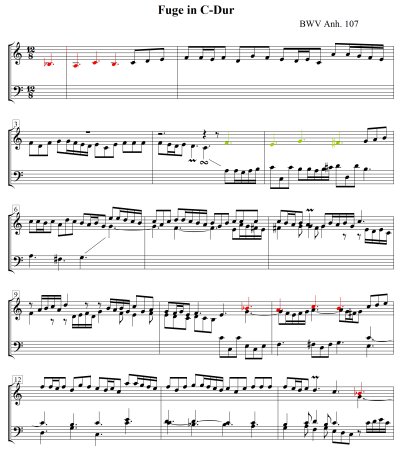
|
|
|
|
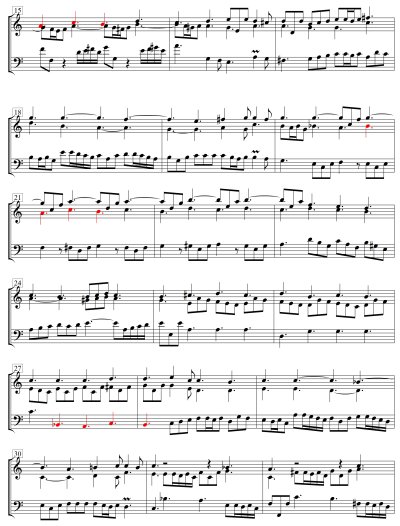
|
|
|
|
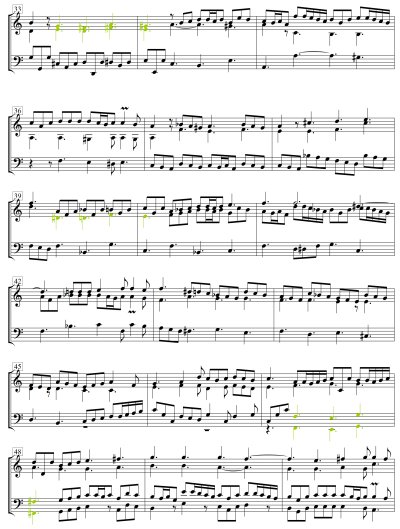
|
|
|
|

|
|
|
|
Georg Andreas Sorge (or Carl Philipp Emanuel Bach) |
Fugue in C major on B-A-C-H, BWV Anh. II 108 (Anh III 181; > H 373), for keyboard
Previously attributed to J.S. Bach
[NBA V/12]
[Wiesbaden: Verlag Breitkopf]
See: NBA analysis above |
|
|
|
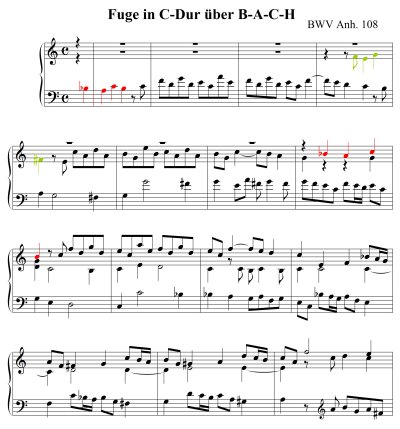
|
|
|
|
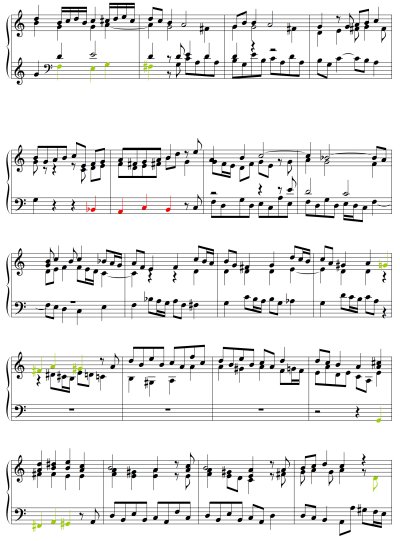
|
|
|
|
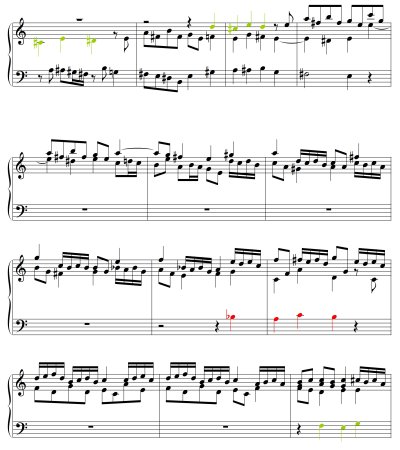
|
|
|
|
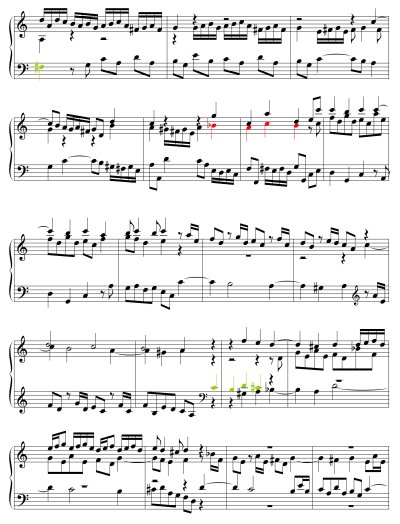
|
|
|
|
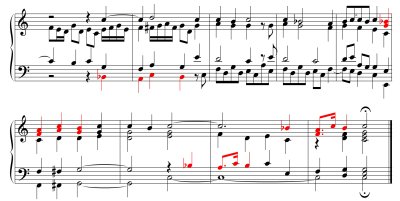
|
|
|
|
Georg Andreas Sorge |
Fugue in C minor on B-A-C-H, BWV Anh. II 110 (Anh III 181), for keyboard
Previously attributed to J.S. Bach
[NBA V/12]
[Wiesbaden: Verlag Breitkopf]
See: NBA analysis above |
|
|
|
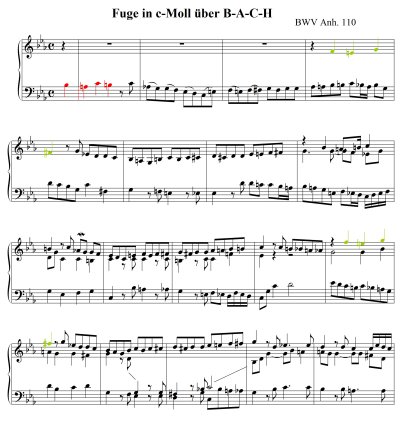
|
|
|
|
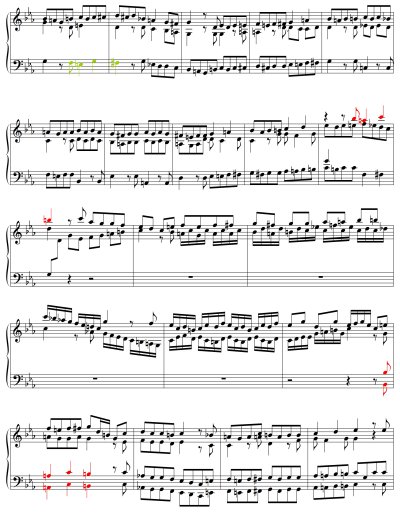
|
|
|
|
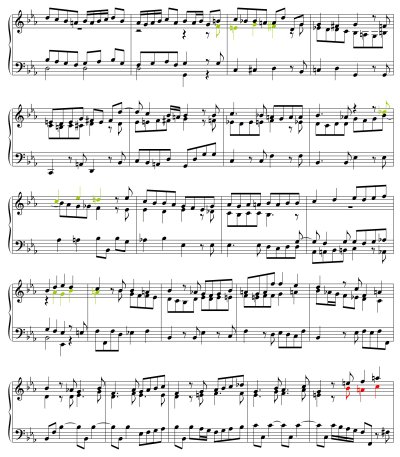
|
|
|
|
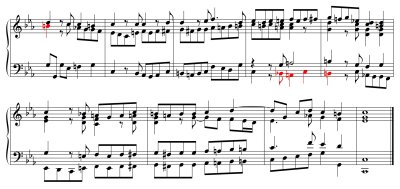
|
|
|
|
Willy Spilling (1909-1965) |
Musik über B-A-C-H, Op. 37, for big orchestra
[Nürnberg: UA, 1957/58] |
1957-1958 |
|
|
Max Springer (1877-1954) |
6 Fughetten über den Namen B-A-C-H, Op. 14, for organ |
|
|
|
Friedrich Wilhelm Stade |
Fugato in B major, for organ (uses the Bach motif) |
|
|
|
Peter Pindar Stearns (b 1931) |
Adagio - B-A-C-H, for organ
[New York: American Composers Alliance. O. J.] |
1968 |
|
|
Gerhard Steif (b 1937) |
B-A-C-H - Zitate, for flute, clarinet, violin, piano, 2 church bells & tape (Georg Eckle gewidmet) |
1985 |
|
|
Carl Steinhäuser (1823-1903) |
Fuge über BACH und HEFE, Op. 53, for organ
[Langensalza: Beyer & Söhne, 1895] |
1895 |
|
|
Raimund Walter Sterl (b 1936) |
Variation, in Divertimento über B-A-C-H [collaborative composition], for orchestra |
1984 |
|
|
Raimund Walter Sterl |
Praeambulum, Choral und Ostinato, for keyboard ad libitum |
1982 |
|
|
Raimund Walter Sterl |
Drei B-A-C-H-Studien, for organ
[Augsburg: Böhm 1984] |
1982-1983 |
|
|
Raimund Walter Sterl |
Arioso, for harpsichord |
1983 |
|
|
Raimund Walter Sterl |
Toccata über B-A-C-H, for harpsichord or piano or organ |
1985 |
|
|
Raimund Walter Sterl |
B-A-C-H-Begegnung, for organ, from Zwei Orgelstücke
[Augsburg Anton Böhm, 2002] |
1997 |
|
|
Raimund Walter Sterl |
Musik über B - A - C - H. The carmans whistle, for harpsichord (piano, organ positiv)
[Köln: Dohr, 2002]. |
1999/2000 |
|
|
Hans Sternberg (1910-1997) |
Sieben Kompositionen für Tasteninstrumente über B-A-C-H, for keyboard instruments
[Coburg: Hans Sternberg, 1986] |
1986 |
|
|
Sigfrid Karg-Elert, revised by Wolfgang Stockmeier |
Introduktion, Passacaglia und Fuge über B-A-C-H, Op. 150
[Wolfenbüttel; Zürich Karl Heinrich Möseler, 2000] |
2000 |
|
|
Erich Stoffers (b 1930) |
Fantasie über B-A-C-H, for organ |
1961 |
|
|
Erich Stoffers |
Drei Fugen über B-A-C-H, for organ |
1983 |
|
|
Erich Stoffers |
Präludium und Doppelfuge, Op. 149, for organ |
1984 |
|
|
Erich Stoffers |
Evolution des B-A-C-H, for organ |
1985 |
|
|
Erich Stoffers |
Triptychon, Op. 150: Präludium – Intermezzo - Toccata mit Fuge, for organ |
1985 |
|
|
Stojan Stojantschev |
Bach Variations, in Divertimento über B-A-C-H [collaborative composition], for orchestra |
1984 |
|
|
Stephan Michael Stoll (b 1963) |
Sonate über B-A-C-H, for organ |
1984 |
|
|
Sigmund Hans Storp (b 1914) |
Acht zweistimmige Inventionen, for piano
[Wolfenbüttel: Möseler 18.471, 1960] |
1960 |
|
|
Harold Stover (b 1946) |
Triptych on the name of Bach, for organ
[New York: Table Eight Music Co., 1986] |
1986 |
|
|
Ulrich Stranz (b 1946) |
Contrasubjekte: Passacaglia über B-A-C-H, for 14 string instruments (8 violins, 3 violas, 2 violoncellos & double bass)
[Kassel: Bärenreiter, 1983, 1980]
[Kassel: Bärenreiter BA 6787, 1984] |
1980 |
|
|
O.N. Stroud |
A Little Fugue on BACH, for solo instrument |
2006 |
|
|
As some composers have done, I have composed this fughetta with the theme of B-flat/A/C/B-natural---or, BACH.
Source: Sibelius Music |
|
|
|
Eugen Suchoň (1908-1993) |
Symfonická fantázia na BACH, for organ, string orchestra & percussion
[Bratislava: Opus, c1973] |
1971 |
|
|
Peeter Süda (1883-1920) |
Prelude and Fugue in G minor , for organ |
|
|
|
The BACH motif figures prominently in this substantial, well-constructed work. Replete with emotional energy, it concludes with a whisper.
Source: Florence Mustric, organist: Reviews |
|
|
|
Ananda Sukarlan (b 1968)
Fantasy and Fugue on B.A.C.H, for piano solo (2015) |
|
B. Sulze |
Präludium und Fuge über B-A-C-H, for organ |
|
|
|
Rudolf Suthoff-Gross (b 1930) |
Partita in E, Variationenfolge über ein Thema aus 36 Tönen, for orchestra |
1965 |
|
|
Jan Pieterszoon Sweelinck (1562-1621) |
Fantasia chromatica, for organ
[Leipzig: Breitkopf & Härtel (Werken voor Orgel of Klavier, Deel I, S. 1-5) 1894] |
|
|
|
György Szabados (1939-2011) |
B-A-C-H Impressions, for piano
[Title track of the album B-A-C-H élmények (Modern Jazz Anthology 64) Qualiton LPX 7279-80] |
1964 |
|
|
Witold Szalonek (1927-2001) |
Little B-A-C-H Symphony:
Fassung 1, for flute, clarinet, violin, vi, cello, double bass, piano & percussion
Fassung 2, for orchestra |
1979/1981 |
|
|
Zsigmond Szathmáry (b 1939) |
Dialog, for organ
[Celle: Moeck, 1971] |
1971 |
|
|
Zsigmond Szathmáry |
B-A-C-H: "Hommage à ...", for grand organ
[Kassel: Bärenreiter-Verlag, c1994] |
1990 |
|
|
Attila Szervác (b 1973)
Bach-20-22 (2016) |
|
|
|
T Bach | A | B | C | D | E | F | G | H | I | J | K | L | M | N | O | P | Q | R | S | T | U | V | W | X | Y | Z |
|
Composer |
Work |
Year |
Works
Recordings |
|
Eduard Terényi (b 1935) |
Partita, for organ |
1967 |
|
|
Eduard Terényi |
B. A. C. H. - Nissal , for organ, Op. 4 |
1967 |
Same work as above? |
|
B. A. C. H. missal for the organ op. 4 (1967) constitutes the prototype of the creation period of the 62s – 72s that is considered by the maestro Eduard Terényi to be “constructivist” or “the crystal music”, that is characterized through symmetry (melodic lines, chords, mirrored rhythmic reports) and also, the closeness to the serialisation through the application of certain pre-established rhythmical-melodically patterns. “Not even a tone is free!” the author declares. The entire musical work has a constructive characteristic, which has the key in the anagram B.A.C.H. The generating motif is extrapolated to other levels of articulation: the rhythmical, the harmonically, the formal, the one of the central tones, the dimensions in bars and that of the macro-organisation of the work. Regarding the circularity idea that is suggested by the B.A.C.H. melodic movement, the formal technique is that of a melodic ostinato, either harmonically or polyphonically.
The B . A. C. H. motif is treated as a micro-series as it can be found in all the four hypostases of the modus quaternion, into transpositions of these and also into permutations and transpositions of the permutations. We can remark the composer’s preference for the symmetrical, palindromical structures: the exposing in a vertical mirror (the recurrence) or the horizontal one (the inversion) of two or more motifs of the B. A. C. H. type; the chords in the mirror.
The rhythmic formulae are generated by a unique proportion of 4 – 3 - 2 – 3, that represents the translation in rhythmic duration of the idea of circularity that is contained inside the melodic line of the B. A. C. H. motif. The entire structure of the musical work symbolizes the circularity through the central tones of every part (pedal tone or the pylon) summing up the letters B. A. C. H., the dimension in bars of the sections of the work give the characteristic report to the fundamental rhythmic formulae: 3 - 2 - 3 - 4. The duration in minutes and seconds of the execution of the parts comes closer to the above – mentioned report.
The connotations of the B. A. C. H motif as symbol of the cross (Kreutzmotiv) are extrapolated to the content of affections and ideas of the whole work. The title could have been Passio – maestro Terényi confesses. As it was composed after the author’s meditations that took place on Golgotha, B.A.C.H. - Missal for Organ carries the connotative semantics of an ideated programme that was declared by the author to refer directly to the suffering, the death and the resurrection of the Saviour.
Source: STUDIA MUSICA - Issue no. 2 / 2009 |
|
|
|
Kerstin Thieme (1909-2001) |
Varianti B-A-C-H, for orchestra & harpsichord or piano
[Berlin: Astoria-Verlag AV 9119, 1993] |
1970 |
|
|
Xaver Thoma |
Cantata Op. 7, for alto solo, choir, strings, timpani & organ
[Eigenverlag thomä] |
1974 |
|
|
Xaver Paul Thoma |
B.A.C.H.: Skizze für Orchester XPT 93 (Picc.3.1.2.1.-2.2 BarHr.3.1.1.,Pk, Schlzg, Klav, Str)
[Bühl/Baden: Antes-Edition Bella Musica Musikverlag] |
|
|
|
Asmus Tietchens |
Studie über B-A-C-H, for Fairlight CMI synthesizer, programmed eight-part brass / tape with three versions |
1983 |
|
|
Frederick C Tillis (b 1930) |
Essay For Orchestra Fugal Fantasy on Bach, for orchestra
[ACA - American Composers Alliance] |
1959 |
|
|
Frederick C Tillis |
Metamorphosis on a Scheme by J.S. Bach, for jazz ensemble (5 sax, 4 tpt, hn, 4 tbn, gt, pno, bass, perc)
[ACA - American Composers Alliance] |
1972 |
|
|
Frederick C Tillis |
Fantasy on a Scheme by J.S. Bach, for soprano saxophone & piano
[ACA - American Composers Alliance] |
1987 |
|
|
Roland Tremain |
Nine Studies, for violin & viola |
1965 |
|
|
Alltonin Tucapsky |
Sonata, for solo violin “Hommage à Bach” |
1985 |
|
|
U Bach | A | B | C | D | E | F | G | H | I | J | K | L | M | N | O | P | Q | R | S | T | U | V | W | X | Y | Z |
|
Composer |
Work |
Year |
Works
Recordings |
|
Viktor Ullmann (1898-1944) |
Piano Sonata No. 7
[Mainz; New York: Schott, 1997-2001] |
1944 |
|
|
In the third movement we smell the air of a familiar planet, as Ullmann deploys the lessons he learned from Schoenberg. It's in the barnstorming finale that the breadth of Ullmann's vision is revealed. It's a set of variations and concluding fugue on what had become an Israeli folksong, a setting of words by the Russian-Jewish poetess Rachel composed in Berlin in 1932 by Yehuda Sharett; and the fugue makes it clear that this is a work of protest: it hints at the Slovakian national anthem and quotes the Hussite hymn Ye who are warriors of God and Nun danket alle Gott, as well as working in the BACH motif.
Source: JMI IFSM newsletter, November 2002 (Viktor Ullmann Foundation) |
|
|
|
Helmuth von Ulmann |
Concerto grosso über das Thema B-A-C-H, Op. 21, for string orchestra
[UA Goslar 1946/47]
[Hamburg: Hans Sikorski, c1996] |
1946-1947 |
|
|
James Underwood (b 1951) |
Variations on B-A-C-H, for orchestra
Premiere: Hayward, California, June 8, 1973 |
1973 |
|
|
V Bach | A | B | C | D | E | F | G | H | I | J | K | L | M | N | O | P | Q | R | S | T | U | V | W | X | Y | Z |
|
Composer |
Work |
Year |
Works
Recordings |
|
Ján Valach |
Mosaik aus b-a-c-h, for organ
[Antwerpen: Digital Music Print, 2000] |
2000 |
|
|
Marios Varvoglis (1885-1967) |
Canon, Chorale and Fugue on BACH, for string orchestra |
1930 |
|
|
Marios Varvoglis |
Prelude, Chorale and Fugue on the name BACH, or string orchestra
[Unpublished] |
1937 |
|
|
Constant Vauclain |
Suite on B.A.C.H., for orchestra (3-fl (1-pc, III), 2-ob, 3-cl (1-bcl, III), 2-bn, 1-cbn, 4-hn, 2-tpt, 3-trb, 1-tb, tmp, prc, str.). |
1976 |
|
|
Mauri Viitala (b 1948) |
Hommage à J.S. Bach, for organ |
1976 |
|
|
Mauri Viitala |
Passacaglia, for organ |
1979-1982 |
|
|
Alexander Villinger (b 1953) |
Kyrie and Gloria, for soloists, choir & orchestra |
1985 |
|
|
Robert Schumann/Henk de Vlieger |
Fuge über den Namen B-A-C-H, Op. 60, 6, arranged for orchestra
[Mainz [u.a.] Schott 2009] |
2009 |
|
|
Ernst August Voelkel (1886-1960) |
Introduzione, Passacaglia und Fuge über B-A-C-H, Op. 122b |
1952 |
|
|
Friedrich Voss (b 1930) |
Sinfonia Humana (= Sinfonie Nr. 3), for orchestra
[Wiesbaden: Breitkopf & Härtel PB 4801] |
1966-1967 |
|
|
Friedrich Voss |
Hommage à J.S. Bach, for 4 saxophones |
1984 |
|
|
Roger Vuataz (1898-1988) |
Conversation avec B.A.C.H., Op. 117 No 1, for bassoon (2nd version)
[Adliswil: Pizzicato Verlag Helvetia, 1999] |
1974 |
|
|
Roger Vuataz |
Conversation avec B.A.C.H., Op. 117 No 2, for clarinet in B flat
[Adliswil: Pizzicato Verlag Helvetia, 2001] |
1973 |
|
|
Roger Vuataz |
Conversation avec B.A.C.H, Op. 117 No 3, for oboe solo (2nd version)
[Adliswil: Pizzicato Verlag Helvetia, 2001] |
1983 |
|
|
Roger Vuataz |
Conversation avec B.A.C.H, Op. 117 No 4, for flute solo
[Adliswil: Pizzicato Verlag Helvetia, 1999] |
1968 |
|
|
W Bach | A | B | C | D | E | F | G | H | I | J | K | L | M | N | O | P | Q | R | S | T | U | V | W | X | Y | Z |
|
Composer |
Work |
Year |
Works
Recordings |
|
Melinda Wagner (b 1957) |
Little moonhead : three tributaries , for solo violin, 2 flutes, string orchestra, harpsichord, & celesta (inspired by Brandenburg concerto No. 4)
[King of Prussia, Pa.: Theodore Presser, 2008]. |
2006 |
|
|
“Ultimately Orpheus was not asking us to live up to Bach or compare ourselves to him. So after the first few days of sitting down with pencil to paper, I had to just rid myself of any kind of apprehension. I decided to adopt the basic elements of the form of Brandenburg Four, its fundamental structure. It’s a very friendly and amiable piece, so I wanted to somehow channel that. The B-A-C-H [motif] at the end—that was just a little bit of gravy.” Melinda Wagner
Source: Orpheus Chamber Orchestra New Brandenburg Concertos |
|
|
|
Rudolf Wagner-Régeny (1903-1969) |
Dsa Bergwerk zu Falun (‘The Mine of Falun’), opera in eight scenes: recurrent B-A-C-H motif
Text: Rudolf Wagner-Régeny, after Hugo von Hofmannsthal’s play
[premiered Salzburg, Festspielhaus, August 16, 1961] |
1961 |
|
|
Rene Wallenstein (b 1947) |
Toccata in meditatione, for organ |
1980 |
|
|
Ludwig Walter |
4 Kanons mit B-A-C-H, for 3 instruments |
1985 |
|
|
Heinrich Weber II {1901-1970) |
Suite über B A C H , for organ
[in manuscript] |
1964 |
|
|
Reinhold Weber (b 1927) |
Fantasia e fuga con risposte alla septima sopra B-A-C-H, for organ, WebWV 8
[Köln: W.G. Haas, 2006] |
1981 |
|
|
Reinhold Weber |
Fantasie und Fuge über B-A-C-H, for piano
[Köln W.G. Haas, 2006] |
2006 |
|
|
Anton Webern (1885-1943) |
String Quartet, Op. 28 (the tone row is based on the BACH motif)
[Vienna: Universal Edition 12399 (Stimmen), (Partitur: Ph. 390)] |
1936-1938 |
|
|
The String Quartet is atonal, and is composed using the twelve-tone technique. The tone row on which the piece is based (B-flat, A, C, B, D-sharp, E, C-sharp, D, G-flat, F, A-flat, G) is intricately constructed and based on the BACH motif (B-flat, A, C, B-natural).
The first four notes of the row are the BACH motif itself, followed by its inversion, followed by same motif transposed up a minor sixth. A special property of this row is that its inversion (G, A-flat, F, G-flat, D, C-sharp, E, Dsharp, B, C, A, B-flat) is equivalent to its retrograde.
Source: Wikipedia |
|
|
|

|
|
|
|
Werner Wehrli (1892-1944) |
Introduktion, Passacaglia und Fuge über den Namen BACH, Op. 41, for organ
[Zürich: Hug]
[Winterthur: Amadeus, 2007] |
1935 |
|
|
Werner Weiand (b 1939) |
Monstranz:
Fassung I, for big orchestra & solo singer (soprano)
Fassung II, for big orchestra & choir |
1979 |
|
|
Sasha Alexander Weinstangel (b 1947) |
Variations, for solo soprano, 2 flutes, string quartet, timpani & vibraphone |
1968 |
|
|
Manfred Weiss (b 1935) |
Concerto in 3 movements, for organ, string orchestra & percussion
[Leipzig: DVfM 1432, 1980] |
1976 |
|
|
Egon Wellesz (1885-1974) |
Partita. In honorem J. S. Bach, Op. 96, for organ
[Vienna: Doblinger 02211, 1967] |
1965 |
|
|
Christoph Ernst Friedrich Weyse; Johannes Frederik Fröhlich; Friedrich Kuhlau. |
Canon über die Noten B A C H. |
|
|
|
Wolfgang Wiemer (b 1934) |
Anläufe, for organ
[Wiesbaden: Breitkopf & Härtel, 1973] |
1972 |
|
|
Wolfgang Wiemer |
Kreuzweg. Vierzehn Stationen nach Holzschnitten von HAP Grieshaber, for organ & slide projector |
1973-1974 |
|
|
James Wilding (b 1973) |
Fantasy on B-A-C-H, for cello & piano
Source: James Wilding |
2003 |
|
|
Frank Wiley (b 1949) |
Fantasie super B-A-C-H, for organ or organ with chimes
[Chapel Hill, NC: Hinshaw c1983] |
1983 |
|
|
Julius Penson Williams (b 1954) |
Fantasy on Bach, for percussion/marim/xyl
1st Performance: Connecticut Valley Youth Wind Ensemble, University of Hartford. Conductor: Peter Boonshaft |
1984 |
|
|
Arthur Wills (b 1926) |
Toccata, Adagio and Fugue on BACH, for organ
Source: Fagus-Music |
|
|
|
Heinz Wunderlich (b 1919) |
Konzert für Orgel und Orchester über den Namen B-A-C-H = Concerto for organ and orchestra on the name B-A-C-H
[Budapest : Editio Musica, 1992] |
1992 |
|
|
Heinz Wunderlich |
Introduktion und Tokkata über den Namen B-A-C-H, for organ |
|
|
|
Gerhard Wunsch (1925-2007) |
Spectrum (= Nr. 6: Invention), in: 30 Studies in Contemporary Idioms, Op. 41, for piano
[Montreal: Boosey & Hawkes, 1978] |
1969 |
|
|
X Bach | A | B | C | D | E | F | G | H | I | J | K | L | M | N | O | P | Q | R | S | T | U | V | W | X | Y | Z |
|
Composer |
Work |
Year |
Works
Recordings |
|
Y Bach | A | B | C | D | E | F | G | H | I | J | K | L | M | N | O | P | Q | R | S | T | U | V | W | X | Y | Z |
|
Composer |
Work |
Year |
Works
Recordings |
|
Hagihara Yoshiaki |
Wakkanai Station - for Johann Sebastian Bach
In: Hagihara Yoshiaki: “Music Of Timetables-For Stations On The Yamanote Line” (Hagihara Yoshiaki) |
2008 |
|
|
Wakkanai Station is the northmost railway station in Japan. Because it has only eight train departures, BACH motif is repeated twice.
Source: CD Baby |
|
|
|
Z Bach | A | B | C | D | E | F | G | H | I | J | K | L | M | N | O | P | Q | R | S | T | U | V | W | X | Y | Z |
|
Composer |
Work |
Year |
Works
Recordings |
|
Daniele Zanettovich (b 1950) |
Passacaglia B.A.C.H. jubilæum, for organ
[Padova: Armelin Musica, 2000] |
2000 |
|
|
Julien-Franyois Zbinde (b 1917) |
Hommage à J.S. Bach. Op. 44, for double bass
[Wiesbaden: Ed. Breitkopf Nr. 6554, 1968] |
1969 |
|
|
Ruth Zechlin (1926-2007) |
Hommage à Bach, for choir: |
1985 |
|
|
Ruth Zechlin |
Musik zu Bach, for orchestra |
1985 |
Recordings |
|
Ruth Zechlin |
Organ Concerto No. 1 |
1974-1975 |
|
|
Friedrich Zehm (b 1923) |
Toccata über B-A-C-H, for organ |
1968 |
|
|
Johannes Zerbe |
Variations |
1983 |
|
|
Sergey Zhukov (b 1951) |
BACH-variations from Sheet Music for piano (Cycle of graphical games: BACH-variations, Triller-restoration, Labyrinth, Dodecardonica, DSCH-variations, CAGE-variations)
[Frankfurt: Russian Music Archive, 2003] |
2003 |
|
|
Bernd Alois Zimmermann (1918-1970) |
Violin Sonata, for solo violin |
1951 |
|
|
Violin Sonata, the first solo work written by the Bliesheim-born composer, is a "12-tone 'Hommage a Bach' - not only because of the B-A-C-H motif that appears transposed in the last movement but more through arpeggios and repeated notes on open strings which, swirled around by multi-voiced figurations, are quite intentionally reminiscent of J.S. Bach's E Major partita." Or, as Zimmermann himself put it in his (posthumously-published) collection of essays, Intervall und Zeit :"The three movements [of the Violin Sonata], Praludium, Rhapsodie and Toccata move from meditative improvisation via a rhapsodic quality to the strict commitment of the Toccata, in which finally B-A-C-H is quoted in honour of the great master of the six sonatas and suites for unaccompanied violin."
Source: Liner notes to the album "Thomas Demenga Plays Bach & Zimmerman" (ECM, 1996) |
|
|
|
Eduard Zuckmayer (1890-1972) |
B-A-C-H Canon in three parts, in Fritz Jöde, Der Kanon, Teil 3, S. 38
[Wolfenbüttel: Möseler 1950] |
1950 |
|
|
Guglielmo Zuelli (1859-1941) |
4-part fugue on the theme proposed by A. Boito: F-e-d-e a B-a-c-h, for organ
[won 1st prize offered by the journal Musica sacra in Milan for composing this work] |
1888 |
|
|
??? |
Improvisation around B-A-C-H MOTIF |
2011 |
|
|
Premiere: Nov 20, 2011 at Forbidden City Concert Hall, Shanghai, China
Source: Bach Cycle 2011 @ Forbidden City Concert Hall |
|
|
|
< Continue from Part 3 |
|
| |
|
Sources: |
|
Schuyler Watrous Robinson : The B–A–C–H Motive in German Keyboard Compositions from the Time of J.S. Bach to the Present (thesis, University of Illinois at Urbana-Champaign, 1972)
Ulrich Prinz, Joachim Dorfmüller & Konrad Küster: Die Tonfolge B–A–C–H in Kompositionen des 17. bis 20. Jahrhunderts: ein Verzeichnis, in: 300 Jahre Sebastian Bach (1985), pp. 389-419 (exhibition catalogue)
W. Hacker: 'Erberezeption im Sozialismus: das Tonsymbol B-A-C-H im Musikschaffen der DDR', Beiträge zur Musikwissenschaft, 31 (1989), pp. 266-278
Malcolm Boyd (Editor): Oxford Composer Companion - J.S. Bach (Oxford University Press, 1999), pp. 50-55
Helmut Föller: B A C H : Verarbeitungen eines Motivs in der Orgelmusik des 19. Jahrhunderts (Sinzig : Studio-Verlag, 2004)
Seyoung Jeong: Four Modern Piano Compositions Incorporating the B-A-C-H Motive (2009)
The Bach motif (Wikipedia) [accessed: July 9, 2011]
WorkdCat Libraries [accessed: July 9-August 4, 2011]
Deutsche National Bibliothek: Deutsches Musikarchiv [accessed: July 9-August 4, 2011]
Oxford Music Online (Grove) [accessed by Thomas Braatz: July 17, 2011]
ACA - American Composers Alliance [accessed August 3-4, 2011]
MGG1
Talk: BACH Motif (Wikipedia (accessed: April 2, 2012) |
|
Prepared by Aryeh Oron (July 2011 - February 2021)
Thanks to contributors: Thomas Braatz (July-August 2011); Evan Cortens (July 2011); Arthur Ness (July 2011) |